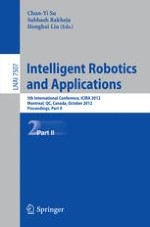The three volume set LNAI 7506, LNAI 7507 and LNAI 7508 constitutes the refereed proceedings of the 5th International Conference on Intelligent Robotics and Applications, ICIRA 2012, held in Montreal, Canada, in October 2012. The 197 revised full papers presented were thoroughly reviewed and selected from 271 submissions. They present the state-of-the-art developments in robotics, automation and mechatronics. This volume covers the topics of robotics for rehabilitation and assistance; mechatronics and integration technology in electronics and information devices fabrication; man-machine interactions; manufacturing; micro and nano systems; mobile robots and intelligent autonomous systems; motion control; multi-agent systems and distributed control; and multi-sensor data fusion algorithms.
